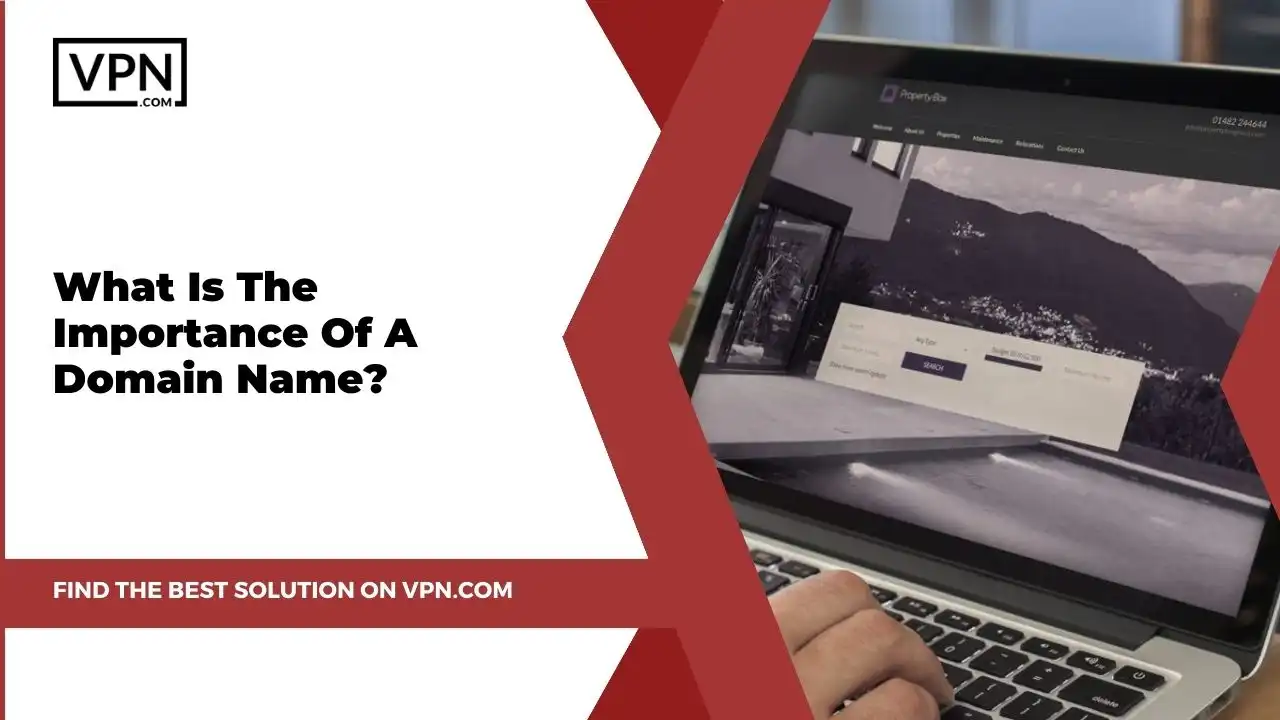How To Change Domain Name Of Your Website? Guide and Tips

Are you considering changing your domain name? As businesses evolve and personal branding strategies shift, the need to change domain names may arise. But how do you go about this process without jeopardizing your online presence?
In this comprehensive guide, we’ll explore the steps you need to take to successfully change domain name while preserving your hard-earned online reputation. Whether you’re a business owner, a blogger, or a website administrator, we’ve got you covered with practical insights and expert advice. Let’s dive in!
What Is The Importance Of A Domain Name?

A domain name acts as your digital identity, representing your brand or website to the online world.
It is crucial to choose a name that aligns with your objectives and resonates with your target audience. However, as circumstances evolve, you may find the need to change domain name while maintaining your online success.

Sign up with our #1 choice
- Experts in Premium Domains
- Ultra-Secure Transactions
- Commissions Starting at 15%
- Paid $1m for VPN.com
- Only Pay When We Succeed for You
- Completely Confidential Transactions
Why Do You Want To Change Domain Name?
Before embarking to change domain name, it’s essential to assess the reasons behind your decision. Are you rebranding? Expanding your business? Or simply looking for a more memorable and relevant name? By identifying your motives, you can make informed decisions throughout the process.
It’s not like we’re trying to stop you from changing the name of your website/blog/business but we want you to know the consequences as most people never recover after the change.
Their sites become a mess with lots of broken & redirect links due to improper website handling & administration. Therefore we recommend you follow this guide step by step to change domain name properly.
Which Measures I Should Take Before Changing My Domain Name?

Proper preparation is key to a change domain name successfully. This section will guide you through analyzing your current name, setting clear objectives, and selecting a new name that aligns with your vision. Here are the steps you should take before changing the name of your website:
- Complete Backup of Your Website
- Download Your Backup File
- Managing SEO and Rankings
- Post-Migration Checks and Testing
- Communicating the Change to Your Audience
Complete Backup Of Your Website
Most hosting platforms automatically take regular or weekly backups of your website to protect & secure your data. And sometimes people also take manual backups of their websites to ensure their search engine ranking and traffic.
No one wants to risk their life-saving/changing data when cybercriminals and server crashes are a normal part of the routine. However, If you really want to make sure that your website will remain as it was before the name change we advise you to take a complete backup of your data.
Download Your Backup File
After taking the backup of your website, it’s time to download the backup file of your website to ensure that your website will remain steady if the server crash or the process of name change fails.
Most people don’t know how important this part is–you have to download your backup file on a daily or weekly basis to maintain your search rankings and website visitors. Your backup will contain the most crucial content of your website including blogs, pictures, videos, internal/external links, etc.
Managing SEO And Rankings
You should take your time and discover strategies to manage your SEO and search rankings during and after the name change. The first step that you have to take is that you will audit your current SEO strategy, update meta tags and page titles, submit a new sitemap to search engines, and monitor and adjust SEO performance to maintain your online visibility.
You have to check the On-Page SEO of all the pages and blogs you have published before. This will cost you a lot of time and money and if you can’t change domain name successfully then you’ll lose your whole website.
Post-Migration Checks And Testing
We advise you to ensure a smooth transition by conducting post-migration checks and testing. You have to verify the functionality of your website, test the website’s loading speed, and check for any broken links that may have occurred when you change domain name.
For most beginners, the name change process is very painful as it cannot only hurt their search rankings but also their daily, weekly, and monthly traffic. We understand that’s the last thing you want before changing the name.
Communicating The Change To Your Audience
Are you a clothing brand that wants to change the location of its stores or expand its businesses? If so, learn how to craft clear and informative announcements and leverage social media channels to engage with your audience’s feedback to ensure a seamless transition.
If you don’t communicate with your customers before changing the name of your website they might not trust you after the changing process. That’s why we’re recommending you make announcements & engage with your audience.
Can I Migrate My WordPress Website To Another Website?

Yes of course you can. WordPress allows you to change domain name of your website by migrating it from one website to another. To migrate your WordPress website, you can use All in One WP Migration, Duplicator, Migrate Guru, and Super Backup & Clone Plugins.
These plugins are very easy to use and even a nontechnical person can use these plugins to migrate their websites in a few clicks. We advise you to use the All in One WP Migration Plugin as it’s free and the most trusted one in the market.

Sign up with our #1 choice
- Experts in Premium Domains
- Ultra-Secure Transactions
- Commissions Starting at 15%
- Paid $1m for VPN.com
- Only Pay When We Succeed for You
- Completely Confidential Transactions
How Can I Migrate My Old Website To The New Domain?
We don’t recommend you change domain name because it can cause a lot of damage. And, not all people can recover from this source. You will not only lose your data but also your search engine rankings and Website traffic.
However, If you still want to migrate your website, read this article till the end to discover the solutions you’re looking for. We’ll cover important tasks such as backing up your website, notifying search engines, implementing 301 redirects, updating internal/external links, and informing your users and subscribers about the change.
What Common Challenges Do You Have To Face When Migrating Website?

When migrating a website, you may encounter several common challenges that can potentially complicate the process. Here are some of the problems you might face after migrating a website:
- Data Loss or Corruption
- Design and Layout Differences
- Broken Links and Redirects
- Database and Content Migration
- DNS and Domain Configuration
Data Loss Or Corruption
During the migration process, there is a risk of data loss due to technical errors, compatibility issues, or improper handling of data. It is crucial to have proper backups and follow best practices to minimize the risk. We recommend you take regular backups of your website before starting the migration process.
Design And Layout Differences
The design and layout of your original website may not translate perfectly to the new platform. Each platform has its own themes, templates, and customization options. As a result, you may need to invest time in adjusting and recreating the design elements to match your original website’s look and feel.
Broken Links And Redirects
When migrating a website, URLs and page structures may change which can lead to broken links if proper redirection is not set up. Broken links can negatively impact user experience and search engine rankings. It’s essential to set up redirects from the old URLs to the new ones to maintain the website’s SEO value and ensure a smooth user transition.
Database And Content Migration
If your website relies on a database to store content, migrating the database to the new platform can be challenging. Database structures and formats may differ between platforms, requiring data transformation and careful handling. We recommend you properly export and import the database while ensuring data integrity and maintaining relationships between different data elements.
DNS And Domain Configuration
Configuring settings, and DNS records, and ensuring a smooth transition of the domain can be a complex task. You have to update DNS records to point to the new hosting platform and set up proper redirection. We want you to understand that DNS propagation can also cause temporary disruptions during the migration process.
Use A 301 Redirect To Prevent Ranking & Traffic Loss

301 Redirect is mostly used when we try to change domain name of a website or when a link is broken. This redirect safely transfers the visitors to the new site without annoying pop-ups and visiting unsecured or harmful websites.
You should be careful when a website redirects you to another page or website because cybercriminals are waiting for the opportunity to steal your data, money, and identity. Now the question is “How will we use a 301 redirect before and after changing the name?” Here is a short step-by-step tutorial that you can use to change domain name:
- Make sure you will not redirect your new name to itself or try to redirect it to your new one
- Visit Admin Settings of your hosting account and find the redirect option in the settings
- Select “Add Redirect” or “Manage Redirect” depending on your hosting account
- Paste your new name in the redirect location of your old setting
- Save the Settings and notify Google about your redirect to prevent ranking & traffic loss
- To notify Google, Use Google Search Console

Sign up with our #1 choice
- Experts in Premium Domains
- Ultra-Secure Transactions
- Commissions Starting at 15%
- Paid $1m for VPN.com
- Only Pay When We Succeed for You
- Completely Confidential Transactions
Conclusion
We hope you like this guide since you read it from the start to the bottom. Now you have a clear idea of how to change domain name and which methods & important points you should consider before you change domain name of your website.
By following the steps outlined in this comprehensive guide, you can confidently change domain name while maintaining your hard-earned online reputation.
Remember, changing the name is an opportunity for growth and improvement. Stay proactive, communicate effectively, and optimize your strategies to thrive in the digital realm.




